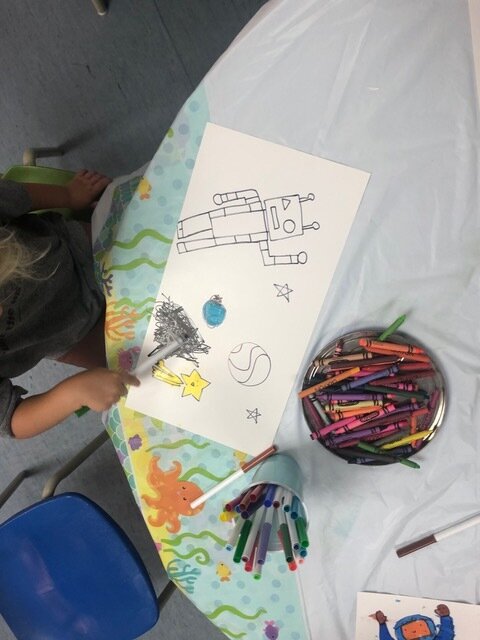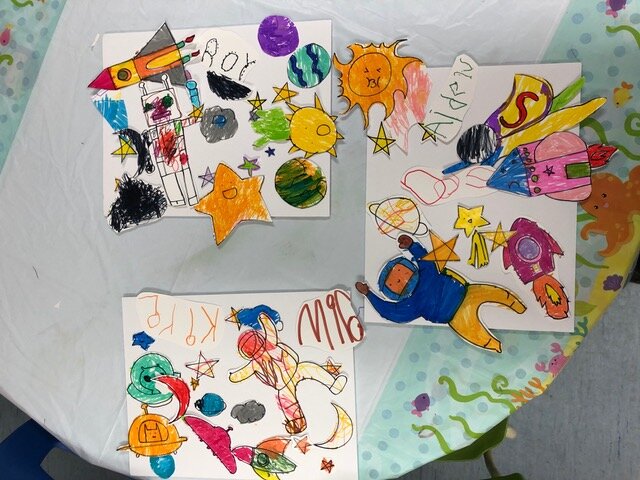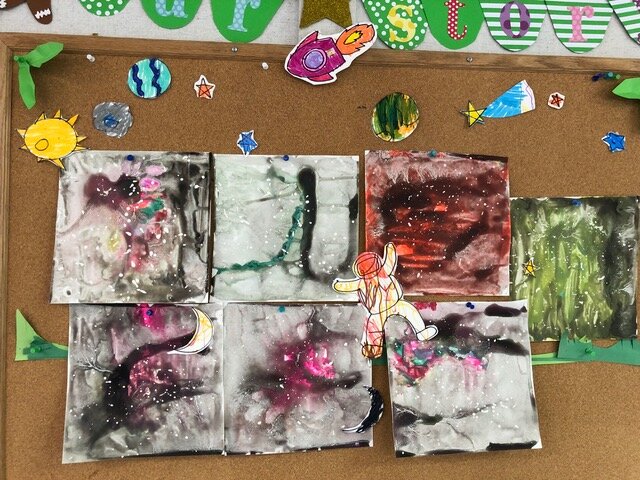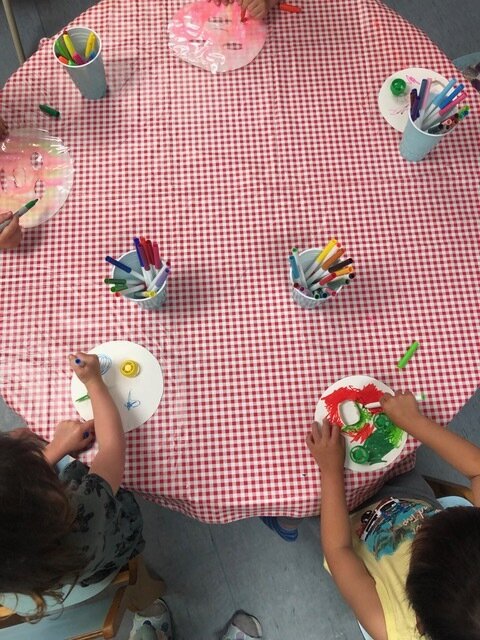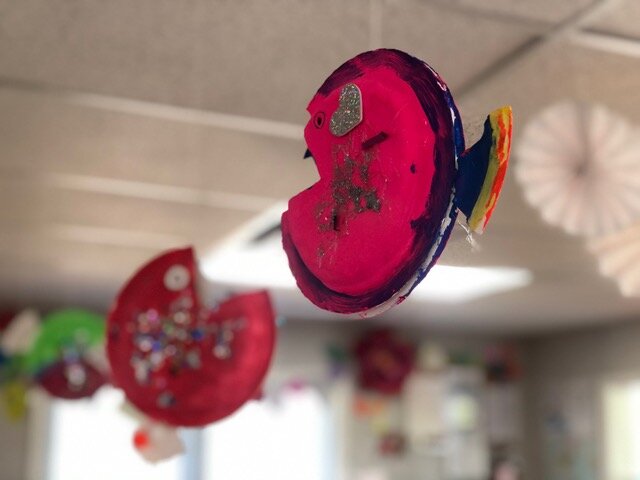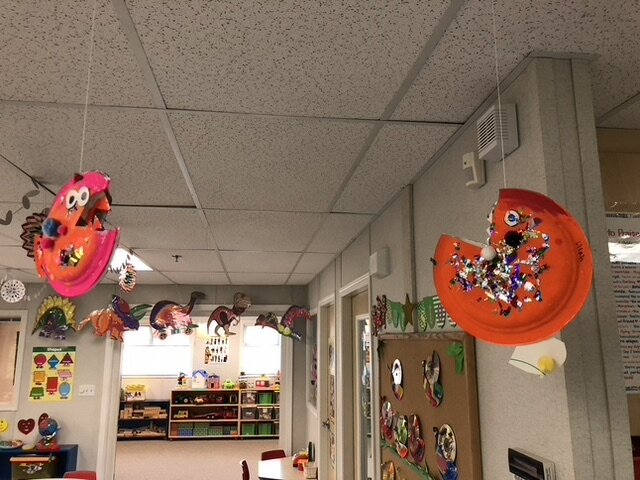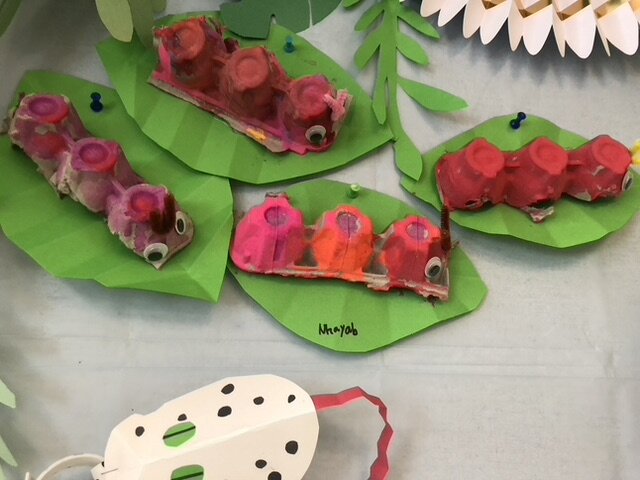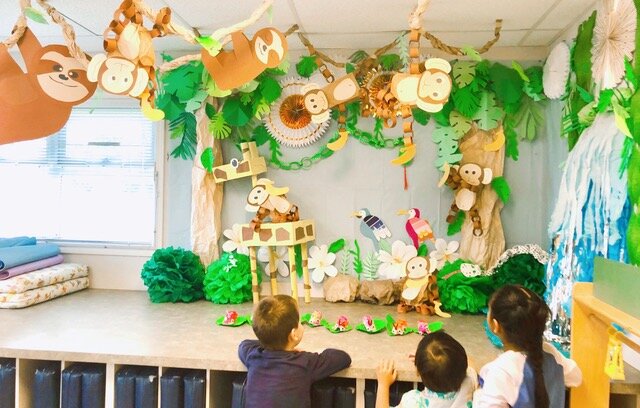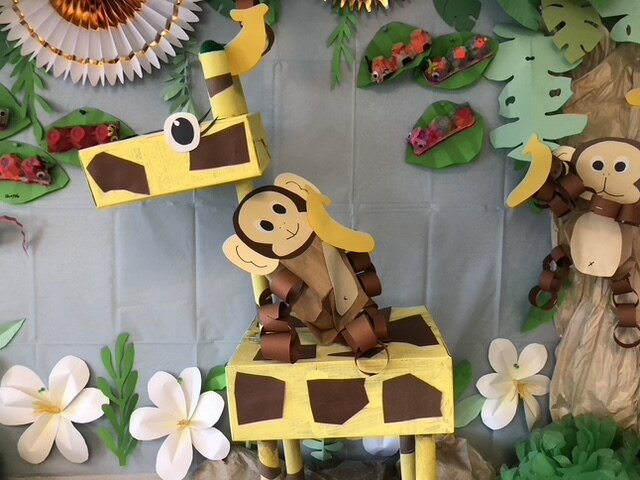Activities for Parents in Vancouver
Remembrance Day Gingerbread House Daycare 2020
“In war there are no unwounded soldiers.”
We care, so we remember.
To commemorate, we have poppies created by our kids and curated by teacher Sun. Happy Remembrance Day!
Art at Gingerbread House Daycare
Our preschoolers are are masters of the moment while having a blast creating with teacher Sun!
It’s so rewarding to watch them express themselves and focus on finishing their projects. Fostering their creativity has far reaching benefits beyond their colourful creations.
Some of the developmental benefits of art include:
Enhanced motor skills - Holding a paintbrush and scribbling with a crayon are essential to fine motor skill development.
Language development - Making art and talking about provides opportunities to learn descriptive words, identify colours and shapes. Growth in emotional expression happens when feelings are about different artwork is elicited.
Decision making - Creating art strengthens critical thinking and problem solving.
Visual learning - Kids are very visual and while many have learned to navigate smart phones and tablets, drawing and sculpting with playdough are fantastic ways to improve visual-spatial skills.
Inventiveness - This happens when kids are supported in taking risks and unleashing their creative potential. This encouragement harness thinking outside of the box and invention.
Cultural awareness - We are fortunate in Vancouver to live in a diverse society. Sun’s classes and projects incorporates aesthetics of color, shape and texture to guide kids in understanding plurality and the concept of multiple realities.
Improved scholastic performance - Kids who participate regularly in the arts are reported to be more likely to participate in math and science fairs, excel as essayists and poetry writing, and be recognized for academic achievements.
Please enjoy the following pictures that exemplify our kids masterpieces. Special thanks goes to teacher Sun for helping these kids go beyond doodling with markers or crayons and for encouraging them to enjoy the process of making art.
COVID-19 UPDATE
Dear Parents,
(Scroll down to “What You Can Do” for updated BC CDC childcare guidelines)
The health and safety of children, families, and child care professionals is government’s top priority. We have continue to receive updated correspondence from Vancouver Coastal Health concerning the COVID-19 virus. The Ministry of Education is in close contact with the Ministry of Health, and the Ministry of Health is taking the virus very seriously. They recognize daycare centers as an essential service for the front line workers keeping the City of Vancouver operating - from the food clerks to the paramedics and nurses. Parents who are able to work from home, should keep their kids home. This helps keep the enrollment of kids low and allows us to safely care for parents that need childcare.
While updated guidelines are in place to support child care centres, we know parents continue to have questions as they transition back to work.
A virtual town hall is being held for parents on Wednesday, March 27 at 3pm, with Katrina Chen, Minister of State for Child Care, Dr. Trevor Corneil, Medical Lead, Office of the Provincial Health Officer, and moderator Jinny Sims, MLA. Parents can watch live on the Government of BC Facebook page or the BC YouTube channel.
FOR THE SAFETY OF ALL OF OUR KIDS AND STAFF:
Parents & kids who have travelled outside of Canada are asked to stay away from the Daycare for 14 days upon arrival
Parents & kids who have been in close contact with someone who has been diagnosed with COVID-19 are asked to stay home for 14 days after their last encounter
WHAT GINGERBREAD HOUSE DAYCARE IS DOING:
Implemented BC CDC Guidelines for Child Care Settings: Sept 25, 2020
Increased frequency of cleaning with medical grade disinfectant in high touch areas (door handles, toddler toys, etc.)
Frequent sanitization of all equipment
Staff and children are reminded to wash their hands frequently
Staff who are not well are to remain home and self-isolate if required
WHAT CAN YOU DO:
Monitor your child/children daily for symptoms, referring to the BC CDC Daily Health Checklist (key symptoms: cough, fever, difficulty breathing, diarrhea, nausea/vomit)
Physical distance and wear a mask during drop-off and pick-up
Frequent hand washing, hand sanitizing and covering your mouth when coughing/sneezing
Avoid touching your eyes, nose and mouth with unwashed hands
If your child feels sick, please keep them at home and avoid all public spaces, including the Daycare, for the duration of their illness (Refer to the BC CDC Guidelines)
If your child has mild symptoms and no fever, keep them at home for 24 hours. If their symptoms improve and they have no fever, they can return to the Daycare
If your child has fever, cough, difficulty breathing, nausea/vomiting, diarrhea - keep them at home and contact 8-1-1 (Refer to the CDC Daily Health Checklist)
Older adults and people who have chronic medical conditions should take the necessary precautions to avoid exposure to others
Avoid close contact with individuals who are ill
Stay informed via the World Health Organization (WHO), Vancouver Coastal Health, Dr. Bonnie Henry and Adrian Dix as well as the BC CDC
We are committed to keeping our kids & staff healthy and will continue to monitor the situation.
Sincerely,
Teachers & Directors for Gingerbread House Daycare
Climate Strike Vancouver
The teachers of Gingerbread House Daycare along with the BC Teachers Federation are in solidarity with all the youth from around the world, including Canada that are striking every Friday to raise awareness about the global climate crisis.
Today, we are in solidarity with the youth of Vancouver who will strike at 1 p.m. at City Hall! If you are able, please take the time to join Vancouver's courageous (and understandably outraged) youth like @sustainteens & stand up for mitigating action. #climatestrike
Healthy Eating and A New Garden !
We at Gingerbread House Daycare are committed to helping kids get excited about eating healthy. So we have partnered with a naturopathic physician and a Vancouver horticulturist to help our kids get excited about growing and eating healthy food.
Let’s grow healthy kids together! Teachers with more knowledge about nutrition and healthy eating can not only lead happier, healthier lives- they can be stronger role models for our kids and be better advocates for school wellness policies.
Since healthy teachers inspire healthy kids, we reached out to a local naturopathic physician who offered us a free 2-hour nutrition class that was fun and inspiring. Not a diet class, but basic nutritional information that was digestible and practical!
Kids are so open to new ideas when they are in a garden. And the staff at Gingerbread are grateful to have partnered with Lynsey, a passionate horticulturist, to create a sensory garden in our front two garden beds. The garden will encourage active learning by giving the chance for kids to taste, smell and learn about herbs and native plants. Lynsey also hosts worm composting workshops for City Farmer, Vancouver’s composting demonstration garden. Preschoolers get so excited about worms and the Daycare staff see this upcoming workshop as an excellent opportunity for our little ones to learn about organic gardening.
This is going to be an exciting school year and we are looking forward to further inspiring our kiddos by starting conversations about planting gardens and healthy eating using books, posters and activities.
Here’s to growing healthy kids together!
Sensory Gardens at our Daycare :) We have a worm composting station too! Kids of all ages love to learn about organic gardening. (Thanks Lynsey for all the awesomeness!!)
Adopting Play & Fitness as a Way of Life for Kids
Most children are not ready to play organized sports until they turn 6. Until that age, encourage your young ones to be active with free play—like running, climbing, and leaping!
More than just a chance to have fun, play is serious business when it comes to a child's health and development. To help keep play a key part of childhood, pediatricians may begin writing a "prescription for play" at every well-child visit through age 2.
Learning is best fueled by tapping into a child's natural urge to play, rather than just outside factors like test scores.
Play is also a great stress buster. In one study, 3- to 4-year-old children, anxious about entering preschool, were two times more likely to feel less stressed when allowed to play for 15 minutes, compared to classmates who listened to a story.
Giving your child plenty of opportunities to play is one of the best ways to help them grow into curious, creative, healthy, and happy adults equipped with the skills they need today.
Some examples of ways to do this:
Six Ways to Help Kids Get to Sleep
If getting your child to sleep is a battle of the wills, you are not alone! Approximately 30 percent of young children have sleep problems and as parents, it's important to explore the cause of their inability to fall asleep or stay asleep before resorting to unnecessary medications.
Good quality, uninterrupted sleep is fundamental for healthy mental and physical development. Sleep has a pivotal role to play in mental health, mood, concentration, and supporting the immune system.
Lack of sleep in childhood is linked to cardiovascular disease, autoimmune diseases, depression, anxiety, cancer and more in adulthood so what we do now for our kids is only going to make their lives, and our lives, that much easier in the future.
The following are six things each family should start exploring and discussing to really figure out why our kids are not getting to sleep.
Routine: This is No. 1 on your list. Kids thrive off of routine and if you are not consistent with it, their sleep will not be consistent. Eat dinner, do bath time, brush teeth and read books at the same time each night. When our kids and their bodies understand the routine, they are less likely to be resistant.
Diet: Dinners should be at least two hours before lights out and packed full of nutrients so they can have that time to digest their food and get good sleep through the night.
Nutrition: Avoid high carbohydrate meals such as pasta, bread and sweets. When we are feeding them sugar, expect a sugar rush and crash. If your child is a picky eater or is going through a "I only eat yellow things" consider speaking to your pediatrician about a multivitamin with B vitamins.
Screens, tablets, video games: Screens, tablets and video games should not be used at least one hour before bedtime, or not at all. Screens are stimulating due to their blue light causing the brain to decrease serotonin and melatonin production and are addictive. Children experience a withdrawal after screen use, just as if you were coming off of a sugar or drug high, which is not ideal for bedtime or sleep.
Bedroom: No screens, TVs or stimulating toys should be allowed in the bedroom. The temperature should be cool and there should be only gentle light allowed.
Exercise/outside time: Kids are never getting enough outside time, especially our school-aged children. Start to incorporate about 30 minutes of outside time right when you get home or right after dinner.
Other things to consider exploring with your pediatrician: food or environmental allergies, vitamin/mineral deficiency.
As you start to make some of these changes, stay firm with your decision and statements to your kids: If you say this is the last time you go into their room, you need to stand your ground and mean what you say. Making changes are hard but in the end, these changes we make for our kids now will only help them become more successful individuals later in life.
Top 10 Brain Boosting Foods For Kids
Food plays an important role in the development of a child’s brain. Children have very active and busy lives, now more than ever before. Their days are long and packed with schoolwork and after-school activities. The brain is constantly working to help fuel thoughts, movements, breathing, etc. Therefore, their bodies and brain need an adequate amount of fuel to stay energized and focused throughout the day. The brain consists of highly metabolically active tissue that requires a constant supply of calories and micronutrients to meet its energy needs. What kids eat or don’t eat can impact their overall development and cognitive function.
Here are 10 foods that can help kids be sharp and get the most out of their learning and activities:
Eggs: Eggs are a great source of high-quality protein and choline. Adequate protein is essential for proper growth and development.
How to serve: Eggs can be served a number of different ways—scrambled, boiled, sunny-side up, over easy, etc. Pick your child’s favorite way of eating eggs and serve with whole grain toast for a hearty breakfast or an after-school snack.
Salmon: Fish such as salmon, tuna, mackerel, etc. contain omega-3 fatty acids, which are crucial for brain growth and development. Including at least two servings/week of omega-3-rich food can help support brain function.
How to serve: Introduce the kids to different types of fish early on, because eating fish/seafood can be an acquired taste for many. Try making salmon patties, tacos, or grilled sandwiches.
Green leafy vegetables: Spinach, kale, collards, etc., not only contain dietary fiber but are also packed with antioxidants and nutrients such as folic acid and lutein, which can help support brain development and memory.
How to serve: Kids usually aren’t thrilled about eating their greens. So, you can try hiding spinach, kale, or other greens into a smoothie, quiche, pasta sauce, or omelet.
Blueberries: Blue and purple fruits and vegetables such as blueberries, purple grapes, and eggplant contain anthocyanins which are shown to support brain health and function by positively affecting memory and focus.
How to serve: Add blueberries to whole grain pancakes and yogurt for a healthy breakfast.
Almonds: Almonds contain vitamin E, an important nutrient that aids with brain functions such as balance and coordination. How to serve: Swapping out peanut butter in sandwiches for almond butter is a great way of incorporating almonds in their diet. Another great way of including almonds is adding them in pesto sauce instead of pine nuts and serving over whole grain pasta.
Meat: Lean meats such as beef, chicken, turkey, etc., are a rich source of vitamin B12. Vitamin B12 is required for cell growth and development. How to serve: Try making beef kebobs or add shredded chicken or turkey in soups, stews, chili, or wraps.
Avocados: Avocados contain a rich supply of monounsaturated fatty acids or “healthy” fats that help deliver adequate nutrients to the brain. How to serve: Avocados are another food that can be an acquired taste. Adding avocado into a smoothie is a great way to mask the taste and add creaminess.
Beets: Beets are a good source of nitrates, which help support blood flow to the brain and promote mental performance. How to serve: When mixed into foods, beets can turn any food into a fun bright jewel color that’s fun to eat. Try mixing beets into hummus, pasta sauce, or hash browns.
Dark chocolate: A small amount (1-2 ounces) of dark chocolate is a great addition to the diet due to the high content of flavonols it contains. Flavonols are plant nutrients containing anti-oxidative properties that may help support memory and brain function.How to serve: Rather than choosing milk or white chocolate, look for at least 70% dark cocoa when selecting chocolate. Instead of giving your children hot chocolate from a mix, create a healthier version by mixing a tablespoon of dark cocoa powder with warm almond milk. Note: dark chocolate has caffeine, so don't give this to kids late in the day.
Turmeric: Turmeric is an ancient spice that has been used for centuries in India. It contains curcumin, a nutrient that gives turmeric its yellow color. Curcumin contains anti-oxidative properties, which may help with brain function. How to serve: Create your version of “golden milk” by adding 1/2 teaspoon turmeric powder to warm almond milk and honey to taste.
Healthy Lunches for Preschool and Daycare Kids
Send your kids back to school with healthy foods in their lunch box! Summer is coming to a close and school is right around the corner. If you are a parent, you are probably cherishing the peace and calm from having your kids at home all summer looking to be entertained. But one of the more challenging things as a parent is coming up with healthy and nutritious snacks on the go for your children – that they’ll eat.
Consider purchasing a bento style lunchbox (we like Onyx stainless steel lunch boxes which are more sustainable on the environment and decrease packaging waste) so you can easily arrange healthy food items. And remember to buy organic whenever possible (especially for animal products like dairy, poultry, and meat).
Here's some helpful lunch menu ideas with healthy food hacks to follow!
MONDAY
- Hard Boiled Eggs
- Baby Carrots + Ranch dressing (consider making your own without the additives and preservatives)
- Peaches
- Applesauce
TUESDAY
- Turkey Slices or roll ups
- Fresh Berries
- Yogurt (sugar free, you can add fresh fruit)
- Trail Mix
WEDNESDAY
- Hummus
- Pita Bread
- Grape Tomatoes
- Cucumber slices
- Sliced Oranges
THURSDAY
- Cheese Quesadilla
- Guacamole
- Salsa
- Tortilla Chips
- Strawberries
FRIDAY
- Shredded BBQ chicken + Cheese Kabobs
- Red Pepper Slices
- Apples
- Carrots with almond butter
Interested in learning more about healthy products and foods for your kids, check out the Environmental Working Groups website. They have everything covered from the best sunscreens to the top rated pesticides in produce.
Water
Plain water is the best drink for kids (and adults). If your child is used to juice and you want to transition her/him to water, try adding a few berries to water for some taste? Some frozen blueberries or raspberries can add some zing to water and keep it cool at the same time.
Sneaky vegetable hack
While you’re steaming carrots, sweet potato or cauliflower for dinner, set a cup or two aside. Blend with ¾ cup of water (more if the mixture is thick) and when smooth and liquidy, add to a thermos lunch, like soup, macaroni and cheese, spaghetti and meatballs. Combine well, and your kids will never know.
Seed/Nut butter apple
Keep skin on apple and use a corer/slicer to remove the core and cut the apple into even pieces. Assemble the apple back together and secure with a rubber band. Add a spoonful of your favourite nut or seed butter (pumpkin or sunflower butters are delicious and safe for “nut-free” schools) inside the cored section and wrap the entire apple in plastic wrap.
When your child unwraps the apple and takes off the rubber band, the apple pieces already have a layer of yummy spread on top!
Reusable lunch containers
Some schools are starting to crack down on plastic bags and wrap and are encouraging parents and students to pack lunches in reusable containers instead. Bento boxes are especially popular. They are already sectioned so lunch and recess snacks are all conveniently packed in one container. Just make sure the plastic is BPA free. You can buy stainless steel snack containers now as well which are much safer in a classroom than glass. I like Onyx, it's expensive, but it'll last a lifetime!
Lunchbox Love
A quick search on Pinterest will lead you to some downloadable daily affirmations that you can print out, cut up and include one in your child’s lunch bag every day. For younger kids that don’t yet read, include pictures of hearts or cute animals hugging to symbolize your love!
Summary
Our staff suggest starting to teach children when they're 1-3 years of age about eating the "rainbow."
Always pack a protein, dairy, meat, nuts and seeds (check your school’s policy on nuts). Also, include fresh cut up veggies, one or two fruit options, apple sauce, cut up apples, peaches, pears. Smaller children do better with cut up fruit. Let kids choose what goes into their lunch, and they will be more likely to eat it. Include more food items than you think they are going to need. Kids self-regulate. Packed with an ice pack, the items that return home can be after-school snacks.
If you are going to use pre-packaged foods, please check food labels carefully to monitor the sugar content in order to avoid hidden or added sugars and preservatives.
One last back to school tip is to send your kids off to school with a reminder of the importance of hand washing prior to eating their lunch and remind them again to do so when they return home. Frequent hand washing is the best defense against getting sick. Singing the alphabet while hand washing can make sure that they’re doing it long enough to count.
To your child's ultimate well-being!
Gingerbread House Daycare







